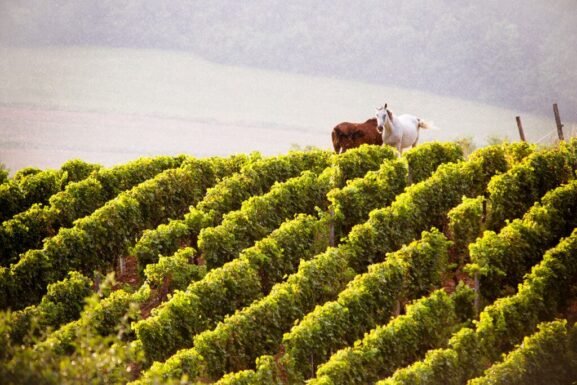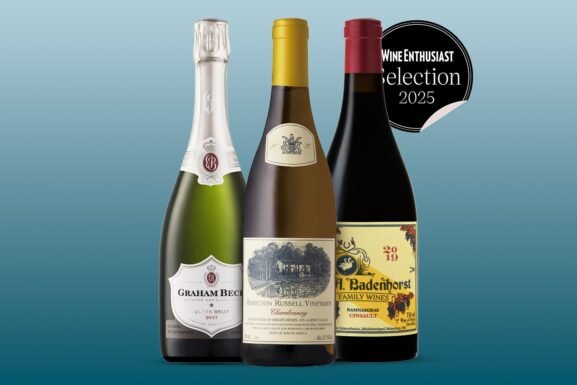The Radical Transformation of London’s Wine Scene
In a 2022 summer travel survey, London emerged as the top destination for Americans heading to Europe. Those interested in its wine culture will encounter a very different scene than in years past.
Over the last decade, London’s wine scene has evolved from stuffy snobbery to increased accessibility. Posh spots that tout Coravin lists are alive and well, but the city’s wine culture has also grown more democratic. It’s been fostered in part by natural wine fairs like RAW WINE and The Real Wine Fair, which helped to introduce consumers to organic and biodynamic practices.
Beyond natural wine, London supports Sherry or bubbles-only bars. The city’s venues offer access to the booming wine industry in Southeast England, where producers make Champagne-quality fizz in small quantities that one might only ever drink at the vineyard or, well, in London.
Centuries of British wine history precede this moment. In 1152, King Henry II married France’s Eleanor of Aquitaine. The union with a dowry that transferred possession of the cities and vineyards of Bordeaux and Gascony to England for the next 300 years.
In 1386, Portugal and England signed a treaty to establish a commercial alliance that would intertwine the fortunes of the Douro Valley with British trade. In 1955, the Worshipful Company of Vintners and the Wine and Spirits Association established the Institute of Masters of Wine, which examination conferring the wine world’s foremost title.
In other words, England and the denizens of London have long trafficked in fine wine.
For those who plan a trip to London or are curious about its wine evolution, here’s a look at the scene through the eyes of the people who helped shape it.
Wine Bars and Restaurants
In 2016, Charlie Mellor founded The Laughing Heart “on the dingiest stretch of Hackney Road,” he says. He wanted to explore design, music, art, lighting and storytelling around wine.
“The Laughing Heart is a cultural, creative practice,” says Mellor. “We see our work as multidisciplinary. It isn’t about simply serving food or wine, but how these ideas come together,” says Mellor.
London’s wine scene is changing, he says. But with that change comes complications.
“It is certainly less uptight, which is great, though sometimes I think that comes at the cost of the quality of the work people do in wine,” says Mellor. “It’s too easy to get a good wine job. I don’t miss the stuffy wine nonsense, but I do miss people working hard to learn about wine. Let’s lose the imposters and keep the groovy, casual narrative.”
A nomadic journey across the hills and valleys of Europe, the Laughing Heart’s wine list focuses on natural producers.
“Within those parameters, wine can be very diverse,” says Mellor. “We love the funky stuff, but I want to have something for everyone, at a broad range of prices.”
When he’s not at The Laughing Heart, Mellor hits up Planque, a new spot nearby.
“These guys have a deep cellar that stems from years of collecting from the owner,” he says. “They don’t put it all on at once, but rather drip-feed to a shorter list.”
Silver Lining, founded by Sarah Maddox and her husband, Alistair, opened in 2016 on Morning Lane in East London’s Hackney district. It was originally a natural wine bar, but the duo’s successful Orange Wednesdays, where glasses of skin-contact wine were offered for five British pounds (approximately $6), led them to rethink the concept. In June 2020, following the pandemic shutdown, Silver Lining reopened as a wine bar and shop that specialized in orange wines, the first of its kind in the U.K.
Sarah says that London’s market has changed, especially since consumer curiosity has exploded. “Where wine tastings may have previously presented barriers due to expense or being trade-focused, they are now more relaxed and accessible and have become social events,” she says.
A torrent of requests from customers who sought wine tastings led Sarah to launch Tasting Notes. It’s a monthly series, where she highlights different topics.
“Over the pandemic, people selected their own wines to enjoy at home, and this naturally led them to seek out ways to become more knowledgeable,” she says.
Silver Lining’s list includes approximately 50 labels that show off the category’s spectrum of styles and flavors. Though the pours change weekly, there’s always a Georgian wine offered by the glass “to pay homage to the birthplace of amber wine,” she says.
With its moody blue walls and colorful modern oil paintings, Silver Lining’s ambiance serves as an extension of the couple’s living room. When they venture out of the “house,” they may head to Planque, or to Sager + Wilde, Bar Crispin, The Mulwray, P. Franco and Leroy in Shoreditch, all of which lean into natural wine to varying degrees.
Brodie Meah worked for years in upscale restaurants before he ventured on his own.
“My experience in fine dining led me to believe wine was sold in a way that was anti-customer,” he says. “It was purposefully portrayed as exclusive and intimidating.”
His first endeavor, Top Cuvée, opened in London’s Highbury district in 2019, cofounded with Max Venning. In contrast to most of the industry, it was a pandemic triumph, thanks to the duo’s ability to pivot through food delivery and wine retail.
On the heels of Top Cuvée’s success came Cave Cuvée, a Parisian-inspired subterranean natural wine bar in East London’s Bethnal Green.
For Meah, Cave Cuvée is all about the atmosphere. A disco ball and an “epic sound system” encourages fun over fuss, he says.
“One of the first things we tell people when they start working here is that wine bars don’t have to be an educational experience,” says Meah. “We don’t automatically give people a spiel about every wine they’re drinking. Really, it’s about hanging out, socializing and drinking things that taste nice.”

Outside of work, Meah frequents Bright, a favorite neighborhood restaurant for its winemaker dinners, and Quality Wines in Farringdon, where he appreciates Nick Bramham’s cooking.
He also loves The 10 Cases. “It’s like a sanctuary of good quality in what can feel like a wine desert in Central London,” he says. “It’s the perfect walk-in spot mid-shopping trip.”
Meah believes that the pandemic cracked open the consumer mindset.
“Lockdowns saw people diverting their restaurant budgets to buying wine and cooking at home,” he says. “People could research wines, which boosted their confidence and as we know, once you get a taste for good wine and develop the confidence to enjoy it, there’s no going back.”
London Hotels for Wine Lovers
Travelers who seek great sips from the comfort of their lodging have plenty from which to choose.
The Connaught’s velvet-curtained Red Room, just off the posh Champagne Room, offers an extensive wine list that includes seasonal selections. Options range from a glass of Vega Sicilia 2011 Unico via Coravin for a whopping £165 ($202), or a down-to-earth 2018 Morgon from Domaine Marcel Lapierre for £18 ($22). The bar’s pink onyx bar and red-flecked fireplace add to the elegant ambiance.
At The Hoxton Hotel’s in Central London’s Holborn district, the team behind Cave Cuvée opened a wine bar and store, Rondo La Cave, replete with snacks and Orange Wine Wednesdays. The adjacent pop-up and incubator kitchen hosts Chet’s, a four-month stint in collaboration with Kris Yenbamroong, the brainchild behind cult natural wine and Thai food spot Night + Market in Los Angeles. Spicy noodles, skin-contact wines and thumping music keep the crowd going all night.
While not a wine bar per se, Pizzeria Mozza at the Treehouse Hotel adjacent to Regent Street offers a tight list of Italian sips to accompany its Neapolitan-inspired pizzas. Bottles from Tuscan winemaker Bibi Graetz are £33 ($40) while glasses of Vermentino, Fiano, and Chianti can be had for less than $10. The quirky, playful hotel encourages socializing in its communal spaces. Don’t be surprised if you encounter like-minded travelers willing to split a bottle or two and a pie.



